I would love to share a fusion curry that I recently prepared. This Chinese-style beef curry is quick and easy to cook and is my family’s favorite.
The proximity of India and China and the globalization of the food industry have made curry a well-accepted dish among the Chinese. Hence, it’s unsurprising to find curry served in Chinese restaurants. However, they have incorporated unique ingredients and cooking methods to adapt to the local palate. As a Cantonese, I have tweaked the recipe with ingredients such as light soy sauce and browning the beef before stewing, which is quite a standard method in our cooking.
This recipe is for you if you want to try a new recipe or want something different from the standard recipe.
Here are the details of my beef curry Chinese-style recipe.
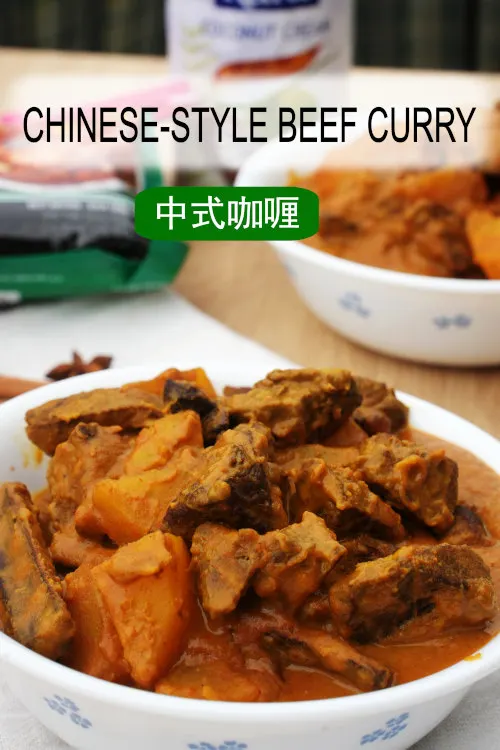
Note: This post may contain affiliate links. Please read my privacy policy for more info. I may receive commissions for purchases made through links in this post. As an Amazon Associate, I earn from qualifying purchases.
1. How to prepare the beef curry (Chinese style)
a. Preparation and steps before cooking the curry
- I’ll cut the beef into small chunks, usually opting for a less expensive cut of meat, for example, rump, as it will become tender with slow cooking.
- Sear it with oil over medium-high heat until the surface is brown. This step adds more flavor since it will produce a different depth of flavor through browning.
- Next, peel the potatoes and cut them to the same size as the chunks of beef. Soak the potato cubes in water to prevent them from changing color if not using them immediately.
- Blend the onion and garlic with a food processor to form a paste.
- Heat some oil in a large skillet or wok. Add the onion paste and saute it until aromatic.
- Add the dry spices – cinnamon, cloves, and star anise – and keep stir-frying for a short while until you can smell their fragrance. Then, add the curry powder and turmeric powder. You should be able to get most of these items at the Asian grocery store or online.
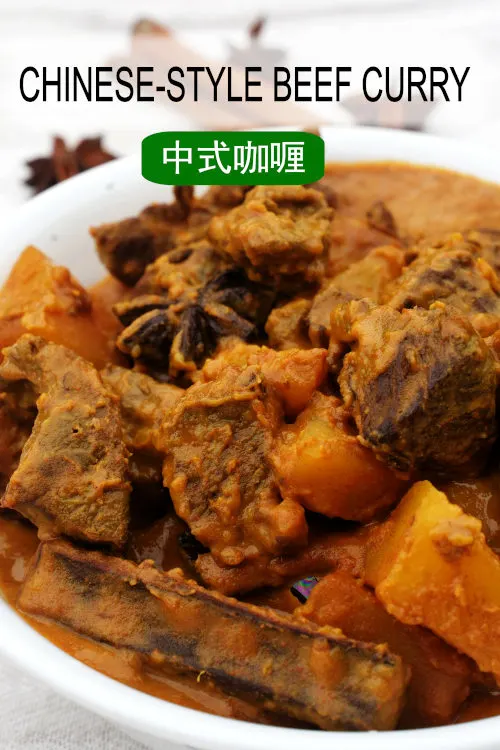
b. Start cooking the curry
- Return the browned beef chunks to the skillet and add enough water to cover them. Bring it to a boil, then reduce the heat to low. Add the light soy sauce and salt to season. Let it stew at medium-low heat for about two hours or until the beef becomes tender. You can cook it on the stovetop or with a slow cooker.
- Check the level of water regularly to ensure it will not dry out. It is better to add hot water to maintain the temperature at a constant level.
- Add the potatoes to the curry about half an hour before the cooking is completed. You can deep-fry the potatoes in hot oil until they turn golden brown before adding them to the curry. It is an optional step that can further enhance the flavor of the curry.
- Once the beef has become tender, add the coconut cream and cook it down to the preferred thickness. I prefer a thicker curry sauce as it has a more concentrated flavor.
- Remember to do a taste test to decide whether to adjust the saltiness according to the curry sauce available. Also, add extra curry powder if you prefer a more intense taste.
This curry tastes different from Indian curry, seasoned with light soy sauce. Its heat level is low as it doesn’t include additional chilies apart from the chili in the curry powder. This type of curry is suitable for most Cantonese, who typically do not prefer spicy food.
c. Cook’s note
- Using any beef stock or chicken stock cubes in this recipe is unnecessary.
- The curry powder mix is the primary source of the curry spices used in this dish. Therefore, please use fresh, high-quality curry powder for optimal results. I use Malaysian meat curry powder, but you can also opt for other brands of Indian curry powders.
- It is important to note that using different brands of curry powder can significantly alter the flavor of the resulting curry.
- Consider making a large batch of curry and dividing it into several air-tight containers to simplify meal preparation. To serve, add a small amount of water and bring it to a boil.
- This curry is also suitable as the curry beef filling for curry puffs or Chinese curry beef buns.
- Consider making a big batch as it is refrigerated well for a few days.
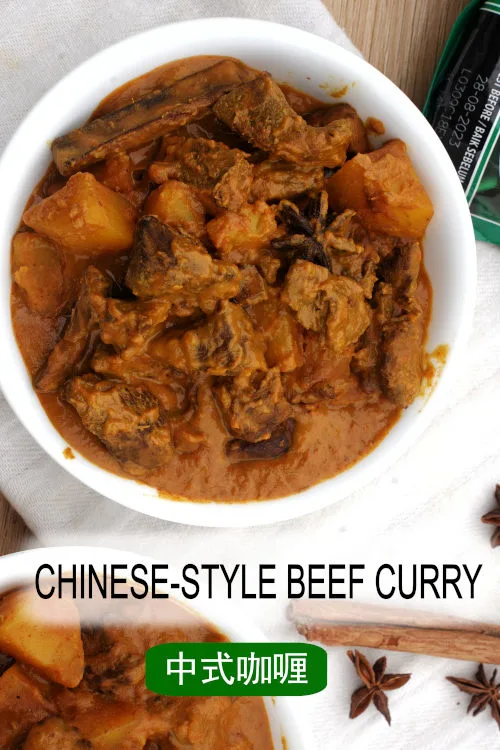
2. Differences between different types of curries
The Chinese-style curry stands out from other variants of curries primarily due to its unique spice profile. While Indian curries incorporate an extensive array of spices, particularly cumin and coriander, Chinese curries limit their spice selection mainly to star anise, cinnamon, and clove. Besides, the Chinese like turmeric, which they use in relatively larger quantities than curries from other countries. In contrast, Malaysian curry uses lemongrass and galangal extensively, imparting a unique aroma. Lastly, Japanese curries are relatively mild and possess a subtle sweetness.
3. Coconut milk vs. coconut cream
The term coconut milk and cream are often used interchangeably. Coconut milk is more diluted, and the fat content is lower than coconut cream. Fresh coconut milk or cream extracted from the coconut is naturally thick and contains approximately 25% fat, making it ideal for cooking curries.
In Malaysia, I prefer fresh coconut milk that extracts directly from the coconut, which I purchase from the local wet market. However, it is more convenient in New Zealand to use coconut milk or cream in tetra packs or cans with 25% fat, which works well for curry recipes.
4. Other related recipes
Here are some recipes related to the beef curry recipe in this article.
- The egg curry recipe uses cloves, star anise, cinnamon, and cardamom, which imbue the dish with a rich and complex flavor. It is also a wonderful way to utilize any leftover eggs.
- The tantalizing taste of Thai red chicken curry stems from the harmonious blend of Thai spices, forming a luscious, velvety gravy. This curry is a must-try if you are a fan of Thai cuisine.
- Aloo gobi is a popular and comforting curry served as a side dish in Indian restaurants. It pairs well with Indian bread, such as paratha, naan, or jeera rice.
Chinese beef curry
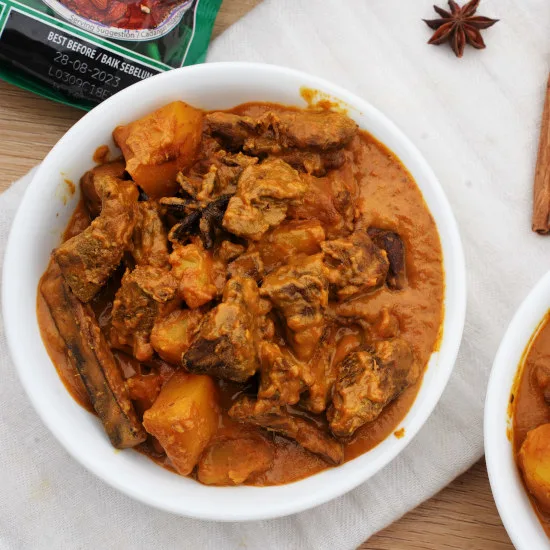
Craving Chinese beef curry? This easy Hong Kong style recipe will satisfy your taste buds and save you a trip to the takeaway.
Ingredients
- 700g beef rump (weight after cut and trim)
- 400g potatoes
- 1 large onion
- 5 cloves garlic
- 2 star anise
- 1 cinnamon stick
- 5 cloves
- 5 tbsp curry powder
- 2 tsp turmeric powder
- 1 tsp salt
- Water to cover the beef for stewing
- 3 tbsp oil
- 125ml coconut cream
- 2 tbsp light soy sauce
Instructions
Preparation and steps before cooking the curry
- Cut the beef into small chunks.
- Sear it with oil over medium-high heat until the surface is slightly charred.
- Peel the potatoes and cut them to the same size as the chunks of beef. Soak the potato cubes in water to prevent them from changing color if not using them immediately.
- Blend the onion and garlic with a food processor to form a paste. Heat some oil in a large skillet or wok. Add the onion paste and saute it until aromatic.
- Add the dry spices - cinnamon, cloves, and star anise - and keep stir-frying for a short while until you can smell their fragrance.
- Then, add the curry powder and turmeric powder.
Start cooking the curry
- Return the browned beef chunks to the skillet and add enough water to cover them. Bring it to a boil, then reduce the heat to low.
- Add the light soy sauce and salt to season. Let it stew at medium low heat for about two hours or until the beef becomes tender.
- Add the potatoes to the curry about half an hour before the cooking is completed.
- Once the beef has become tender, add the coconut cream and cook it down to the preferred thickness. Now it is ready to serve.
Recommended Products
As an Amazon Associate and member of other affiliate programs, I earn from qualifying purchases.
-
 Pre-Seasoned Cast Iron Skillet 2-Piece Set (10-Inch and 12-Inch) Oven Safe Cookware - 2 Heat-Resistant Holders - Indoor and Outdoor Use - Grill, Stovetop, Induction Safe
Pre-Seasoned Cast Iron Skillet 2-Piece Set (10-Inch and 12-Inch) Oven Safe Cookware - 2 Heat-Resistant Holders - Indoor and Outdoor Use - Grill, Stovetop, Induction Safe -
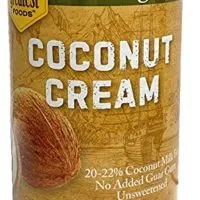 Nature's Greatest Foods, Organic Coconut Cream, No Guar Gum, Unsweetened, 13.5 Ounce (Pack of 12)
Nature's Greatest Foods, Organic Coconut Cream, No Guar Gum, Unsweetened, 13.5 Ounce (Pack of 12) -
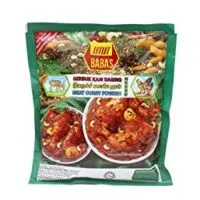 BABA Meat Curry Powder 500g - 17.64oz
BABA Meat Curry Powder 500g - 17.64oz -
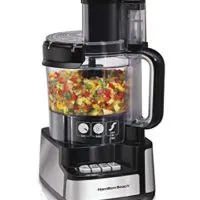 Hamilton Beach 70725A 12-Cup Stack & Snap Food Processor and Vegetable Chopper Black
Hamilton Beach 70725A 12-Cup Stack & Snap Food Processor and Vegetable Chopper Black
Nutrition Information:
Yield:
3Serving Size:
1Amount Per Serving: Calories: 1197Total Fat: 68gSaturated Fat: 27gTrans Fat: 2gUnsaturated Fat: 36gCholesterol: 228mgSodium: 1685mgCarbohydrates: 73gFiber: 11gSugar: 31gProtein: 76g
This data was provided and calculated by Nutritionix on 11/4/2023

KP Kwan
Wednesday 12th of April 2023
Hi, this is KP Kwan. I am happy to see you in this comment area, as you have read through my recipe. I am glad to reply to any questions and comments as soon as possible.